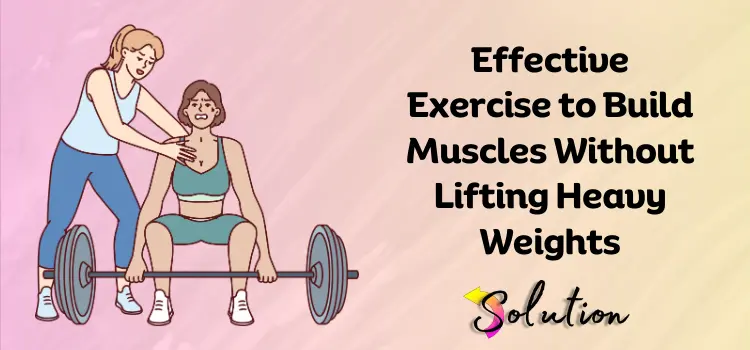
Have you ever been at the gym, working hard, only to glance over and see someone next to you lifting heavier weights with an impressive, muscular physique? It can feel a bit intimidating, right? I’ve been there too! Sometimes, I’d spend the whole day thinking about their incredible body and wishing I could push myself to lift more.
But guess what? You don’t have to feel embarrassed anymore because I’ve discovered a secret: you can build the muscles you want without lifting heavy weights! Let me show you how.
Yes, you heard that right—you can build the body you want without lifting super heavy weights! The key lies in focusing on a few essential techniques, all of which are outlined in this guide. There are so many ways to build muscle and boost your strength—like resistance band workouts, high-rep exercises, and using progressive overload techniques. And that’s just the beginning! Ready to learn more? Continue scrolling to discover all the tips and tricks waiting for you in this blog.
Before we start, remember this: hard work always pays off. Stay consistent and trust the process—keep pushing forward, and before you know it, you’ll start seeing the results you’ve been working for!
4 Exercises for Building Muscles Without Lifting Heavy Weights
Building muscle without lifting heavy weights may be accomplished by performing various workouts, including a few components in your diet, and focusing on progressive overload, which involves progressively increasing the intensity over time. Below is a list of effective workouts that you may practice to observe results in your physique.
Resistance Band Exercise
You can use resistance bands, which are large elastic bands, to train any part of your body. We recommend this workout to persons who have restricted mobility since many of the exercises may be completed while seated. Another thing to remember is that if you have a heart issue or high blood pressure, you should see your doctor or a cardiac rehabilitation specialist. Here are a few exercises that use resistance bands:
1. Band Pull-aparts
In this exercise, you must hold a resistance band with both hands at shoulder height in front of you while maintaining your arms straight. Then, carefully pull the band apart by pushing your hand outside while maintaining your arms outstretched. Finally, squeeze your shoulder blades together at the completion of the action and return to the beginning position.
This exercise for the upper back and rear shoulder improves posture and develops the muscles responsible for supporting the shoulder blades. Instead, you can perform banded rows, lateral band walks, and banded squats. All of these exercises will help you develop biceps, hips, and glutes.
2. Biceps Curls
To complete this exercise, stand in the middle of the band with both feet and grip the ends in your hands. Now keep your hands up and elbows tight to your torso. Simply bend your elbows to curl your hands toward your shoulders, then gently drop them back to their starting position.
This workout will assist your biceps, which are located in the front of the upper arm. Your muscles will feel more toned and stronger. If you want to make it more difficult, try performing incline bicep curls.
High-rep Exercise
The second exercise that we propose is a high-rep exercise, which is performed with lesser weights or body weight while focusing on higher repetitions. They are excellent for increasing muscular endurance, generating hypertrophy, and improving form with extended muscle stress. Here’s a full overview of high-rep workouts, including how to do them and their advantages.
1. Lateral Raise
Begin by holding a light dumbbell in each hand at your sides, palms toward your thighs. After that, stand with your feet shoulder-width apart, back straight, and core engaged. Slowly lift your arms to the sides, producing a “T” shape. And effortlessly return the weights to their initial position in a regulated manner.
This allows you to strengthen muscles on your shoulder, maintain it more defined, and improve the upper body’s aesthetics and stability. This exercise will aid in addressing any possible strength disparities between your right and left sides.
2. Overhead Triceps Extensions
If you already know how to execute this exercise, great if you’re not sure, don’t play with your body and learn how to perform overhead triceps extension. Hold a light dumbbell in both hands and hoist it over your head, arms fully extended. Here, slowly bend your elbows to reduce the weight behind your head while maintaining your upper arms motionless.
Extend your arms back to their original position. Repeat for the appropriate number of times. After performing this, you will have gorgeous triceps and increased arm strength and definition, with a focus on the triceps for a toned look. Please keep the head in a reasonably neutral posture do not allow the neck to protrude forward, since this places too much strain on the cervical spine.
Bodyweight Exercises
Bodyweight workouts are a powerful technique to increase strength and endurance without using any equipment. They are adaptable, scalable, and appropriate for any fitness level. Here’s a thorough description of the bodyweight exercises listed, including how to do them and which body regions they target.
1. Push-ups
Begin in a high plank posture, with your hands slightly wider than shoulder width apart. Then you must keep your body in a straight line from head to heels while engaging your core. Lower your body by bending your elbows until your chest is barely above the ground. Push through your palms to go back to the beginning position.
You may perform this in a variety of ways, including wide-grip, which targets the chest, diamond, which focuses on the triceps, inclination, which is an easier version, hand on a raised surface, and decline, which is a more difficult version, feet elevated. Typically, the chest, shoulder, triceps, and core are the primary targeted muscles.
2. Planks
Perform this exercise in a forearm plank posture, elbows under shoulders. Keep your body in a straight line from head to heel. Engage your core and prevent sagging or arching your back. Simply hold as long as possible while keeping proper form. This exercise also has other variants, including side planks, which target the obliques.
If you want to focus more on dynamic core engagement, do the plank with a shoulder tap. Plank to push-up, which increases intensity and targets the core, shoulders, and lower back. People who want to improve their stability and posture likely advise this workout.
Progressive Overload Technique
Progressive overload is a key approach for muscle and strength development that entails gradually increasing the complexity of workouts to push your muscles and drive growth. You can use this approach for bodyweight, resistance band, and high-rep workouts. Here’s a more detailed explanation of how it works, complete with workout examples, progression tips, and targeted body parts:
1. Push-up (Upper Body)
To apply progressive loading, increase the reps/duration, beginning with 10 reps and progressively increasing the number or holding the reduced posture longer. Then increase resistance by placing a resistance band over your back or wearing a weighted vest. To increase the intensity of your decline push-ups, elevate your feet.
This will help you develop your chest, triceps, core, and shoulders. Strengthen the upper body, activate stabilizing muscles, and increase endurance. Handstand push-ups are an advanced activity that works your entire upper body, including your shoulders and core.
2. Lunges (Lower Body, Balance)
Begin with 10 repetitions on each leg, gradually increasing. To increase explosiveness, execute jump lunges to stimulate fast-twitch muscle fibers. To add weighted variety, carry tiny weights or resistance bands to improve resistance. This will improve quadriceps, glutes, calves, and hamstrings. Furthermore, it strengthens the lower body while improving coordination and balance.
Lunges also have the benefit of requiring the body to work throughout the eccentric period. When it comes to hypertrophy and muscle growth, studies show that eccentric muscle contraction is more effective than concentric muscle contraction. If you just have time for a few exercises, it’s best to include ones that engage numerous joints at once.
Read Also:- The secret to building lean muscles
End note!
Building muscles without lifting large weights demands more than simply workouts it necessitates deliberate attention to complex but sometimes neglected details. First, emphasize progressive overload by gradually increasing the duration under stress or resistance levels. Nutrition is critical—prioritize protein-rich meals, balanced macros, and adequate water to promote muscle repair and development. Recovery is equally important get enough sleep and integrate stretching or mobility exercises to avoid stiffness and injuries. Finally, consistency and mentality are important measuring improvements and remaining diligent with your program are critical to long-term success. These elements, when coupled, can dramatically improve muscle-building results.


